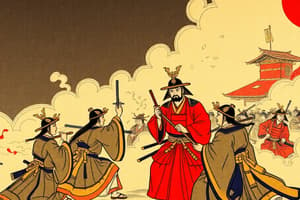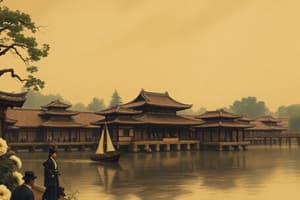Podcast
Questions and Answers
Which of the following factors contributed most significantly to the economic hardship faced by the samurai class during the late Tokugawa period?
Which of the following factors contributed most significantly to the economic hardship faced by the samurai class during the late Tokugawa period?
- The fixed income based on rice stipends diminished in value due to inflation and economic stagnation. (correct)
- Increased opportunities for samurai to engage in trade and commerce eroded their traditional values.
- The shift in economic focus from rice to manufacturing drastically reduced the demand for samurai skills.
- The samurai class were forced to sell of their land as a result of the increased taxation policies implemented by the Tokugawa Shogunate.
What was the primary motivation behind the Meiji government's decision to implement state-led industrialization?
What was the primary motivation behind the Meiji government's decision to implement state-led industrialization?
- To create a completely socialist economy that would equally benefit all citizens.
- To promote free market capitalism without government intervention.
- To maintain the traditional class structure and prevent social mobility.
- To rapidly modernize Japan and strengthen its military to resist Western imperialism. (correct)
How did the arrival of Commodore Perry impact Japan's foreign policy during the late Tokugawa period?
How did the arrival of Commodore Perry impact Japan's foreign policy during the late Tokugawa period?
- It reinforced the shogunate's commitment to isolationism by highlighting the dangers of foreign contact.
- It led to the immediate adoption of Western political systems and democratic reforms.
- It prompted Japan to open its ports to trade with the U.S., exposing its military weakness and leading to unequal treaties. (correct)
- It strengthened the Tokugawa Shogunate's authority and stability by demonstrating its ability to negotiate with foreign powers.
Which of the following best describes the political system established by the Meiji Constitution of 1889?
Which of the following best describes the political system established by the Meiji Constitution of 1889?
What was the main purpose of the 'sakoku' policy implemented by the Tokugawa Shogunate?
What was the main purpose of the 'sakoku' policy implemented by the Tokugawa Shogunate?
How did the abolition of the feudal domains and the creation of prefectures impact Japan's political structure?
How did the abolition of the feudal domains and the creation of prefectures impact Japan's political structure?
Which of the following statements best describes the attitude of Japanese intellectuals toward the Tokugawa Shogunate's isolationist policy in the late Tokugawa period?
Which of the following statements best describes the attitude of Japanese intellectuals toward the Tokugawa Shogunate's isolationist policy in the late Tokugawa period?
Which social class was at the bottom of the Tokugawa Shogunate's rigid class system?
Which social class was at the bottom of the Tokugawa Shogunate's rigid class system?
Which of the following best describes the role of the zaibatsu in Japan's modernization during the Meiji Restoration?
Which of the following best describes the role of the zaibatsu in Japan's modernization during the Meiji Restoration?
How did the Meiji government reform the education system in Japan?
How did the Meiji government reform the education system in Japan?
What was the significance of the Anglo-Japanese Alliance of 1902?
What was the significance of the Anglo-Japanese Alliance of 1902?
Which of the following was a major social change that occurred during the Meiji Restoration?
Which of the following was a major social change that occurred during the Meiji Restoration?
What was the primary goal of Japan's military modernization during the Meiji period?
What was the primary goal of Japan's military modernization during the Meiji period?
Which of the following describes the state of Shinto during the Meiji Restoration?
Which of the following describes the state of Shinto during the Meiji Restoration?
How did land reform contribute to Japan's modernization during the Meiji Restoration?
How did land reform contribute to Japan's modernization during the Meiji Restoration?
What was a significant continuity in Japanese society despite the rapid modernization of the Meiji Restoration?
What was a significant continuity in Japanese society despite the rapid modernization of the Meiji Restoration?
Which of the following events solidified Japan's position as a major world power after the Meiji Restoration?
Which of the following events solidified Japan's position as a major world power after the Meiji Restoration?
Which of the following best describes the foreign policy pursued by Japan after the Meiji Restoration?
Which of the following best describes the foreign policy pursued by Japan after the Meiji Restoration?
Flashcards
Tokugawa Shogunate
Tokugawa Shogunate
Feudal military government ruling Japan.
Sakoku
Sakoku
Policy of strict isolation, limiting foreign contact.
Rigid Class System
Rigid Class System
Social divisions based on hereditary status.
Commodore Perry's Arrival
Commodore Perry's Arrival
Signup and view all the flashcards
Treaty of Kanagawa (1854)
Treaty of Kanagawa (1854)
Signup and view all the flashcards
Meiji Restoration (1868)
Meiji Restoration (1868)
Signup and view all the flashcards
Meiji Government Aim
Meiji Government Aim
Signup and view all the flashcards
Meiji Constitution
Meiji Constitution
Signup and view all the flashcards
Zaibatsu
Zaibatsu
Signup and view all the flashcards
Meiji Restoration
Meiji Restoration
Signup and view all the flashcards
Land Reform (Meiji)
Land Reform (Meiji)
Signup and view all the flashcards
Shinto (Meiji Period)
Shinto (Meiji Period)
Signup and view all the flashcards
First Sino-Japanese War
First Sino-Japanese War
Signup and view all the flashcards
Anglo-Japanese Alliance (1902)
Anglo-Japanese Alliance (1902)
Signup and view all the flashcards
Russo-Japanese War (1904-1905)
Russo-Japanese War (1904-1905)
Signup and view all the flashcards
Class System Abolishment (Meiji)
Class System Abolishment (Meiji)
Signup and view all the flashcards
Okubo Toshimichi
Okubo Toshimichi
Signup and view all the flashcards
Ito Hirobumi
Ito Hirobumi
Signup and view all the flashcards
Study Notes
No new information was added to the study notes, as all the information was already present.
Studying That Suits You
Use AI to generate personalized quizzes and flashcards to suit your learning preferences.




